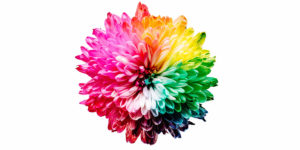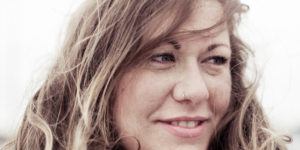The 5 Keys to Trusting Your Heart and Acting From a Place of Inner Wisdom
BY JOHN PRENDERGAST
 in order to access your deepest inner wisdom, you must learn to trust your heart. photo: julia caeser
in order to access your deepest inner wisdom, you must learn to trust your heart. photo: julia caeser
Openheartedness is one of the most easily recognizable somatic markers of inner knowing. The heart is a highly sensitive center of feeling and knowing. It has many levels and remarkable depth. It is our
most intimate area, the one we are quickest to protect. We often touch ourselves in the heart area when we are referring to ourselves or when we are feeling close to another. When the heart area is open, there is a subtle sense of warmth, expansion, sweetness, and aliveness. We feel loving and connected. A different quality of knowing emerges, one that is spontaneous, direct, and unconcerned with outcomes. Our willingness to not know, to not rely on our ordinary thinking mind for guidance, and to let attention rest in the heart area opens up a door to a different way of knowing and trusting. As we do so, we become much more accepting and compassionate with ourselves and others.If our heart has been closed and then begins to open, we often discover why our native sensitivity originally shut down. Old emotional wounds will surface and ask for our attention. Difficult feelings such as grief, shame, self-loathing, personal deficiency, despair, and fear can arise. We may feel sensations and see images of embedded shards or an apparently bottomless dark pit. Most of these emotionally painful layers are personal and relational in origin, the results of old betrayals, disappointments, abandonments, and assaults. Some are existential, shared by all humans, such as Kelly’s fear of dying and being no one. Opening and trusting our hearts requires courage, dedication, and a willingness to be deeply vulnerable. As this opening happens, it is important that we meet our old wounds and contractions with understanding and compassion.
“The Heart is another name for Reality and this is neither inside nor outside the body.”
— Ramana Maharshi
A great deal of my work with people is helping them to get out of their heads and into trusting their hearts. As I mentioned in chapter 2, the spiritual journey is in large part about this transition. When our attention naturally rests in the heart center, we feel at home in ourselves and the world. We have easy access to the wisdom of the heart.
Following the Path of the Heart
We are often encouraged to “follow our hearts,” but what does this really mean? How can we tell if we are ensnared in some delusion and riding an emotional fantasy or listening to true inner guidance? The inner knowing of the heart is often obscured by fears, desires, and limiting beliefs. How do we go forward with any confidence? It seems that we must feel our way forward, step by step, continually listening and adjusting as we go, learning to trust the heart fully.
The Keys to Trusting Your Heart
Key 1. Trust Your Heart Physically:
+ Place your hand over the center of your chest and imagine that you are directly breathing into and from the depths of your heart area.
Following the path of the heart requires discernment. Love needs to be tempered by wisdom. Heart wisdom is a combination of love and clear understanding. Love without wisdom is naïve and easily leads to disastrous relationships, as almost all of us can attest to. Love can blind us so that we see only what we want to in the other person. The honeymoon phase of a relationship reflects this strong tendency to idealize. We hope so much that the other will fulfill us that we happily overlook their needs and limitations.
Discernment—clear-sightedness—pierces these illusions without devaluing the other. It allows us to have a balanced view and to see them as they are.
If you follow and trust your heart wisdom and things don’t work out as you expect, it doesn’t necessarily mean that you have made a misstep. There may be a vital lesson that we needed to learn. In fact, there is no objective way to determine if we have done the “right” thing. Our lives unfold more like meandering rivers than freeways. One thing is clear: if we are generating more suffering for ourselves and others, it is important to slow down and take an honest and intimate look at how we are functioning. in order to trust your heart, you must often take a leap of faith… but with great faith comes great reward. photo: flo-flash photocase.com
in order to trust your heart, you must often take a leap of faith… but with great faith comes great reward. photo: flo-flash photocase.com
When I talk about trustworthy guidance with my clients and students, I emphasize that our inner guidance is ultimately what we need to rely on. The rest of our guidance comes from the law, societal norms, and family conditioning. These external guides have their legitimate roles to play; however, in the end we must check inside to feel what is true for ourselves. At some point we have to kick off the training wheels and trust our inner sense of balance. I have trusted this inner guidance with all of my major decisions around career, relationships, and spiritual path. I am grateful that I have, even as this process has led to some highly unlikely twists and turns. I never would have guessed that my life would unfold as it has.
“At some point we have to kick off the training wheels and trust our inner sense of balance.”
There were some critical junctures in my life where the wisdom of the heart revealed itself, and I decided to act on it. Sometimes it came as a quiet knowing and trusting in the heart, other times in a vision or dream. Reflecting back on my life, I can see that I usually needed to admit my confusion and ask for guidance before I was in touch with it. Humility was important. I offer the following example from my first marriage to encourage you to trust your inner knowing and follow it.
I briefly met Linda at an Association for Transpersonal Psychology conference in Pacific Grove, California, in 1981. We both signed up for a weekend workshop on developing intuition, which would take place the following month in San Francisco. Although Linda came to the workshop with her boyfriend, she and I paired up in a dyad and mutually experienced a profound connection. I felt like we had known each other in another life—some ancient recognition had reawakened. It seemed that she knew my heart from the inside. At the end of the workshop, she told me that her teacher, the venerable Tibetan Buddhist master Kalu Rinpoche, would be giving a talk the following night. Did I want to come? Of course!
I arrived at the door of the hall at exactly the same time as Linda, who had her boyfriend in tow. We sat next to each other, and during Kalu’s talk, I felt my energy body completely blend with hers. To my astonishment, it felt as if an inner marriage had occurred, yet there was nothing I could say about it. So instead, I said a friendly goodbye. I broke off my relationship with my girlfriend the next day and asked Linda out on a date that weekend. It turned out that she had experienced the same thing sitting next to me at Kalu’s talk. On our second date two days later, I proposed to her, and she accepted. As I drove home, I was stunned at what I had done. It was completely out of character with my normally cautious style. And Linda still needed to tell her boyfriend!
When we met again a few days later, Linda revealed that she had a number of life-threatening illnesses, including pulmonary hypertension, and offered to release me from my commitment. I was again stunned and inwardly torn. The inner connection felt so true, yet the outer circumstances looked impossible. Linda had a life expectancy of five years, according to her doctors, and no savings or health insurance. I was a grad student with little money. How could this relationship possibly work? My mind told me that it was completely insane to marry her, while my heart told me to stay. After agonizing for several days, I decided to trust my heart and go ahead with the engagement.
Linda was hospitalized several months before our marriage and needed a medical team to pull her back from the edge of death. She lived for nearly seven more years, and we enjoyed a wonderful relationship. At the time, I had never felt so intimately known and loved in my life. Although the last years were very difficult for both of us as her health declined, I never regretted my decision to marry her.
At the beginning of January 1989, Linda told me that she would die in twenty-eight days. She asked me if I knew who would be my next partner. It was a sincere question, and I knew it deserved an honest response. I told her that I thought it would be Christiane, whom we both knew through the Jean Klein fellowship. There was no outer reason for me to think this since Christiane and I were just friends at the time. Linda nodded and said Christiane would be a good partner for me. Twenty-eight days later, Linda went into a diabetic coma and was taken to the hospital by paramedics. She was discharged and returned home briefly before again losing consciousness in the early hours the next morning. She was rushed to the hospital, but this time she did not recover. Her death was only a few hours later than she had predicted.
The Keys to Trusting Your Heart
Key 2. Trust Your Heart Mentally:
+ Inquire into any beliefs that obstruct your love and the acceptance of yourself and others.
When I saw her lifeless body full of tubes at 2 a.m. in the vacant emergency room, I knew that it was not Linda. It was her body, and she was clearly gone. I retreated to the chaplain’s office in shock and tried to quiet my mind. To my astonishment, I felt Linda’s presence within me and heard her loving voice distinctly say, “Do not grieve for me. I am happy to be free of this body.” Then I felt her leave, accompanied by a rush of energy out the top of my head.I couldn’t sleep that night. I felt as if I had witnessed, and in some way participated in, an inner rocket launch. I was on a high for several weeks until a huge wave of grief came crashing in. I was not grieving for her so much as for myself. Despite my glimpse through the veil of life and death, I experienced a terrible emotional emptiness in my heart that felt like a bottomless, dark crater. For months the grief came in waves with varying respites. An occasional sneaker wave would pull me completely under. I would toss and tumble in grief for hours until I was spit out, exhausted.
The following year, Christiane’s visa was about to expire, requiring her to return to France. I was still deeply grieving Linda’s death and knew that I was not emotionally ready to marry, yet circumstances required that I act. I trusted my inner knowing that my heart would eventually be more available. We got married sooner than I would have normally wanted. I am very grateful that I did. Christiane and I had a wonderful son, James, and a new chapter of my life unfolded as my heart gradually reopened to deeply love them both.
A Blind Man Sees
One of the most inspiring stories about trusting your heart and following inner guidance is found in Jacques Lusseyran’s autobiography And There Was Light. This underground spiritual classic is still largely known by word of mouth. It deserves a much wider audience. Lusseyran, born in Paris in 1924 to a middle-class family, lost his sight in an accident at school when he was eight years old. At first he felt anguish and despair, but he soon realized he was looking at his situation in the wrong way. This was more than a simple insight—it was a revelation:
At this point some instinct—I was almost about to say a hand laid on me—made me change course. I began to look more closely, not at things but at a world closer to myself, looking from an inner place to one further within, instead of clinging to the movement of sight toward the world outside. Immediately the substance of the universe drew together, redefined and peopled itself anew. I was aware of a radiance emanating from a place I knew nothing about, a place which might as well have been outside me as within. But radiance was there, or, to put it more precisely, light. It was a fact, for light was there. I felt incredible relief. Confidence and gratitude came as if a prayer had been answered. I found light and joy at the same moment, and I can say without hesitation that from that time on light and joy have never been separated in my experience. I have had them or lost them together.
“I trusted my inner knowing that my heart would eventually be more available. We got married sooner than I would have normally wanted. I am very grateful that I did.”
Lusseyran’s story is even more remarkable for what followed. He was seventeen when the Nazis invaded France and occupied Paris. Driven by an inner resolve from the core of his being, he became a major leader of the Resistance, organizing a group of over six hundred young men to clandestinely produce and distribute an anti-Nazi newspaper throughout France and to help downed airmen find safe passage to Spain.
Lusseyran, known as the Blind One, would personally vet each new member of his group in order to detect possible Nazi collaborators. He could read others with extraordinary accuracy and gained a reputation for being infallible. He was, however, ambivalent about only one member that he accepted. This man betrayed him and the entire leadership a year later. Lusseyran and his comrades were arrested by the Gestapo, interrogated, and shipped to Buchenwald. After nearly dying there, he became an informal spiritual counselor to many of the men because of his inner radiance. He was one of the few to survive.
We are all blind in a way until, like Lusseyran, we learn to “look from an inner place to one further within.” It is one thing to discover this inner light, and it is another to let it guide us in our daily lives. For Lusseyran, this guidance took the form of great insight, courage, and compassion in the most demanding circumstances imaginable. Although he almost lost his life, he never lost his “sight,” even in the depths of Nazi hell.
Self-Love and Self-Acceptance
Sometimes my spiritually oriented clients wonder whether self-love, self-acceptance, and self-care will reinforce the ego. They don’t. Loving and accepting ourselves as we are allows us to step off the inner battlefield and to relax the knot of inner division.
The Keys to Trusting Your Heart
Key 3. Trust Your Heart Emotionally:
+ Attune with that deep place in the heart that loves and accepts everything just as it is.
+ Visualize embracing any parts of yourself that need this love. Hold them in your heart.
+ Do the same for others—inwardly bless them and wish them well.
+ Be generous in expressing your heartfelt love in daily life.
Self-indulgence is different from self-care. Self-indulgence feeds the sense of being a separate self. When we become self-indulgent, our life is all about the little me. We don’t really care about others or for the whole of life. Self-care means that we listen to our core needs, set reasonable boundaries with others, and live in balance. It also means that we question all of our limiting beliefs that create suffering for ourselves and others. And it means that we live in growing integrity with a deeper truth that we are not separate from anyone. Genuine self-care frees us to be more selfless.
Our basic needs are fairly simple—food, shelter, rest, health, human connection, and meaningful work. If we don’t take basic care of ourselves, we are unable to really help anyone else, at least not for long. Burnout—becoming exhausted, sick, and resentful—is pointless. There are times when we need to stretch beyond our normal limits in order to be there for others or to meet a work commitment. At some point, however, we need to rest and replenish. The wisdom of the heart helps us to navigate these apparent dilemmas of when to say yes or no to the requests or demands of others. Sometimes a no will be the most wise and loving response in the long run, even if it temporarily disappoints someone. A no to someone else can be a yes to our inner truth.
“The wisdom of the heart helps us to navigate these apparent dilemmas of when to say yes or no to the requests or demands of others.”
Self-love and acceptance can easily begin as mental principles that transmute into ideals against which we judge ourselves. For example, we may think, “I should be more self-accepting.” The judging mind is so tricky; it will use anything to point out what is wrong or missing and thus reinforce a core limiting belief. For this reason, sometimes it is not that helpful to encourage people to accept themselves. If they have a hard time doing so, they will feel like failures. Further, injunctions engender resistance. We don’t like being told what to do, even if wisdom is being offered with the best of intentions.
I noted in chapter 4 of my book that the conditioned mind only accepts conditionally. It is always bargaining along the lines of “If I accept this, maybe I can get rid of it.” So rather than enjoining my clients and students to accept or love themselves more, I ask them if they can find that awareness in the heart that already loves and accepts them as they are.
Trusting Your Heart Exercise: Self-Love and Self-Acceptance
Find a quiet place, sit comfortably, and close your eyes. Bring your attention to your heart center. Take several slow, deep breaths and let your attention settle down and in. Ask yourself: Is there something within me that loves and accepts me just as I am? Let the question go and be quiet. Notice what happens in the area of your heart. If you can sense this place of self-love and acceptance, attune with it and let it in. Notice the impact as you do. Then imagine embracing the part of you that feels unacceptable and unlovable in the center of your heart. Rest and breathe. Let the love saturate this part for several minutes. (If you are unable to sense this place, ask yourself if there is a core belief about whether you are lovable and acceptable as you are. Then follow the experiment in chapter 4 about questioning core beliefs.)
We find unconditional acceptance in the depths of the heart. The deeper our attention goes, the more compassion and understanding we discover. It is as if there is a secret spring in the core of the heart. The Spanish poet Antonio Machado writes of this in his poem “Last Night as I Was Sleeping”:
Last night as I was sleeping,
I dreamt—marvelous error!—
that a spring was breaking
out in my heart.
I said: Along which secret aqueduct,
Oh water, are you coming to me,
water of a new life
that I have never drunk?
Last night as I was sleeping,
I dreamt—marvelous error!—
that I had a beehive
here inside my heart.
And the golden bees
were making white combs
and sweet honey
from my old failures.
Last night as I was sleeping,
I dreamt—marvelous error!—
that a fiery sun was giving
light inside my heart.
It was fiery because I felt
warmth as from a hearth,
and sun because it gave light
and brought tears to my eyes.
Last night as I slept,
I dreamt—marvelous error!—
that it was God I had
here inside my heart.
Soul: The Inner Sanctum
In chapter 2 of my book, I described three levels to the heart: ego, soul, and self. The egoic level is concerned with our self-image and its related feelings of pride, shame, self-esteem, and self-loathing. This level goes very deep, and much of our attention is ordinarily absorbed in maintaining an image acceptable to ourselves and others. The questions that arise from this level are: Do you see me? Am I okay? Do you like me? There is a natural desire and need to be accurately and appreciatively seen and to have what is seen reflected back to us—in psychological terms, to be mirrored. A certain amount of mirroring is necessary for attention to move beyond the self-image and self-story. Receiving it supports our self-trust and the ability to stand on our own.
My clients and students often report journeying through increasingly subtle layers of their hearts. As they do so, they discover why they closed their hearts and put up a series of barricades in the first place. Each wall is connected to an old emotional injury—a deep hurt due to abuse or neglect that was too much to bear at the time. Sometimes these walls appeared suddenly, and other times they appeared incrementally. They often arose without the person’s conscious awareness, particularly if this happened in early childhood. It was easier and safer to shut down and armor the heart than to stay open and feel.
“Wounds to the heart are usually relational in origin, so the healing will often come through the loving acceptance and attunement of another person.”
It takes courage and vulnerability to reopen these sensitive depths. Wounds to the heart are usually relational in origin, so the healing will often come through the loving acceptance and attunement of another person, be it a family member, friend, partner, or therapist. This process of healing takes time.
As the heart heals and clears, greater depths unfold. At some point, we may encounter what feels like a sacred core—what some call the soul. It is the place of greatest relational intimacy, whether we are relating as spiritual friends or lovers. Here the heart is undefended, innocent, and open. Each individual offers complete access to the other. It is a place of love, gratitude for life, compassion, appreciation, and joy. It is deeply touching to sit with people and experience their journey into this inner sanctum together.
The Keys to Trusting Your Heart
Key 4. Trust Your Heart Energetically:
+ Sense into the various layers of your heart including the inner sanctum at the back of the heart.
+ Sense into the opening behind the heart into the infinite or Great Heart.
Much of Rumi’s poetry describes this depth of intimacy, which for him sprang out of the brief but extraordinarily transformative time he spent with his teacher Shams. Will Johnson, author of Rumi: Gazing at the Beloved—The Radical Practice of Beholding the Divine, offers the following poem, among others from Rumi, as evidence that Shams and Rumi spent most of their ninety days together gazing:
If you want to know God,
Then turn your face toward your friend,
And don’t look away.
I have found that meditative gazing with an open friend or partner tends to evoke this soulful level of contact. A deep longing of the heart is fulfilled when this level of relational intimacy is touched. The taste of these sacred waters is extraordinarily sweet.
Gazing with a partner is a beautiful practice that I highly recommend. When meditatively gazing with someone, it is best to have no agenda and simply be open to what unfolds in the moment. It is never the same experience from session to session. You can go as long as you like, although thirty minutes is usually sufficient. Have a timer or clock nearby and find a space where you won’t be interrupted. The intention with this practice is simply to be open to what unfolds within you and between you and your gazing partner.
Trusting Your Heart Exercise: Gazing with a Partner
Sit comfortably across from your partner. Close your eyes for a minute and relax. Feel your feet on the floor, your breath, and your whole body.
Open your eyes and make relaxed, non-effortful eye contact. Allow your eyes to be soft and receptive. Be natural and at ease. This is not a staring contest. Feel free to blink, briefly close your eyes to rest, or adjust your posture as needed.
Stay at home in yourself and receive your partner. If you notice yourself being drawn into your partner’s experience, gently recenter.
Be open and nonjudgmental. Don’t try to hold onto or push away any experience. Silently notice what arises without trying to change it in any way.
Allow at least five minutes at the end to verbally share your experience with each other.
The Great Heart
As the heart opens and awakens, a universal, all-embracing love may emerge. When I interviewed my friend Dorothy Hunt, she described the awakening of her heart and the experience of this love:
Sometime later, [there was] another awakening—of the heart. Deep tears of allowing life to enter the tabernacle of the Heart—a space once “reserved” for God. Now there was nothing that was not God. There was a sense of nectar flowing through the body—warm, sweet, loving presence, bathing in it, being overcome by love for everything and everyone. Seeing an arm, an eye, the skin, hearing music, birds singing—overwhelming love. Nothing was separate; nothing apart from love. Love beyond any description of love. Overwhelming love, overwhelming gratitude. Unsteadiness on the feet in the face of overwhelming love.
The heart area in the body is the portal to the Great Heart. Some of my clients and students have experienced the back of their heart area opening up into what feels like infinite space behind and around their bodies, as Kelly reported at the beginning of this chapter. It is as if there is a backdoor in the temple of the human heart that opens out to the cosmic heart. Only this Great Heart can fully embrace the collective suffering of humanity that is too much for an individual human heart to bear. As the heart fully flowers, we realize that we are all in this together, that the suffering of apparent others is also our suffering. It is the deep nature of the heart to reach out and embrace this suffering—to gather it into itself. Love is willing to go to hell.
“The heart area in the body is the portal to the Great Heart. Some of my clients and students have experienced the back of their heart area opening up into what feels like infinite space behind and around their bodies.”
One of my clients, Michele, recently experienced this Great Heart firsthand during a session of EMDR. Although she was raised in the Jewish faith, she grew up in a Catholic culture and felt an unlikely affinity with Jesus and Mary (although not the orthodox teachings of Christianity) throughout her life. At the end of our session, she was astonished at what had unfolded:
I have trouble breathing; my lungs refuse to take in enough air. I look inside myself, and I am stunned to see my heart covered with gaping wounds flowing with immense grief. It’s not my grief, but a grief gathered from each of us humans, a collective grief joined together in a dark river. I ache deep in my chest and bones. Sobs burst out of me while my body contorts and the dark flow increases. I don’t want to escape but to fully meet this river of human sorrow and misery. I open to it as much as I can; my body trembles, my teeth chatter. The grief comes in waves, increasing. My heart stretches and stretches but still is not big enough to let it all pass through.
I won’t turn away but invite more. I welcome the unbearable because there is nothing else to do, nowhere else to go; this river must fully flow through my heart to free it.
Suddenly, Christ’s Heart appears in front of me, a couple of inches away, the river of all sorrows flowing through it. Our hearts get closer and closer. As if being pulled by a powerful magnet, my heart moves toward Jesus’s Heart. Drawn from the inside by that mysterious force, it stretches even more, touches It and finally enters and melts in It. Thorns are piercing my head and arms. I sense the rough wood of the cross against my body and the nails. It is as if I am being crucified.
I realize then that the pain of Christ on the cross was not all about the acute suffering of the body, being torn apart, the nails, the thorns, the wounds, but that it was the dark flow of mankind’s suffering passing through His pure heart, filling it with grief, darkness, and ignorance. That pain was so much more immense and excruciating—a pain reaching from the four corners of the world, gathering the darkness of each one of our human hearts.
The Keys to Trusting Your Heart
Key 5. Trust Your Heart Spiritually:
+ Make a deep commitment to live openheartedly. Then work steadily and compassionately toward keeping it.
+ Rest in and as the open heart.
+ Gaze with a spiritually oriented friend.
I do not know how, but I suddenly understand that all pains need to go there to start healing. None can be outside; not even the smallest fragment can be separated from that Heart. Pain needs to be unified to heal, and this is what Christ is doing. Unbelievably, I clearly experience the great love of Christ gathering all pain in Himself, unifying it, for ultimate redemption.
As the moment passes, I see that there is only One Heart in the whole world; it’s so obvious, there are no separate hearts anywhere. That One Heart calls each of us to itself. I can hear it now and it is engulfing me through Christ’s love.
The call of Christ’s heart, by gathering all of humanity’s darkness in itself, starts the ultimate healing, the sacred healing into truth. The Universal Heart is where all pain must go and where the darkness that envelops mankind must find it.
I tremble and sob; John holds my hands, and I plunge even deeper. The cross finishes its work of gathering pain through Blessed Jesus and His soul consumes the suffering harvested.
Then, finally, it is finished. I feel gratitude for the ending. What felt unbearable and sacrificial is over. The Cosmic Heart beats its beat, pulling and calling each individual heart to fully join and heal through the truth of unity.
I am dizzy and need to lie down while Oneness moves in me for a moment, and I see the dark shadow of a startled and rigid ego looking at it from out there. I am amazed.
In this remarkable session, Michele clearly tapped into the Great Heart that is able to gather in and transmute the collective suffering of humanity. It was almost unbearable, yet something in her felt compelled to experience it. This session marked a turning point for Michele, who is a highly sensitive person. She began to find her way out of a long period of intense darkness and suffering. I felt as if I had witnessed and participated in a sacred event.
Summary of the Keys to Trusting Your Heart
Openheartedness is one of the most easily recognizable markers of inner knowing. The human heart is a keenly sensitive area of feeling and knowing that is a portal to our deepest self. Heart wisdom is a blend of deep feeling and understanding. Without discernment, love is easily blinded by desire. The heart area closes in the face of early emotional abuse and neglect, as well as in response to the normal challenges and stresses of daily life. It reopens when it is met with steady, attuned love. Self-acceptance, self-love, and self-care free us from our egocentricity and open us to the whole of life. The mind can only accept conditionally, but the heart accepts unconditionally. We do not need to try to love or accept ourselves; it is enough to attune with the love and acceptance that is already here.
“The human heart is a keenly sensitive area of feeling and knowing that is a portal to our deepest self. Heart wisdom is a blend of deep feeling and understanding.”
As our attention deepens into the heart, subtler dimensions unfold. The deepest dimension of the human heart, sometimes called the soul, feels like a sacred temple. It is here that we experience the greatest human intimacy, love, compassion, and joy. The human heart opens into a non-localized Great Heart that is capable of embracing the suffering of humanity. Discovering and consciously living from both the Great Heart and the soulful depths of the human heart brings the deepest happiness as human beings.
The Keys to Trusting Your Heart: Attuning with Openheartedness
Key 1. Trust Your Heart Physically:
+ Place your hand over the center of your chest and imagine that you are directly breathing into and from the depths of your heart area.
Key 2. Trust Your Heart Mentally:
+ Inquire into any beliefs that obstruct your love and the acceptance of yourself and others.
Key 3. Trust Your Heart Emotionally:
+ Attune with that deep place in the heart that loves and accepts everything just as it is.
+ Visualize embracing any parts of yourself that need this love. Hold them in your heart.
+ Do the same for others—inwardly bless them and wish them well.
+ Be generous in expressing your heartfelt love in daily life.
Key 4. Trust Your Heart Energetically:
+ Sense into the various layers of your heart including the inner sanctum at the back of the heart.
+ Sense into the opening behind the heart into the infinite or Great Heart.
Key 5. Trust Your Heart Spiritually:
+ Make a deep commitment to live openheartedly. Then work steadily and compassionately toward keeping it.
+ Rest in and as the open heart.
+ Gaze with a spiritually oriented friend.
This article on trusting your heart is excerpted with permission from In Touch: How to Tune in to the Inner Guidance of Your Body and Trust Yourself by John Prendergast.
About The Author
John Prendergast, Ph.D., is a native of the San Francisco Bay Area who studied at UC Santa Cruz before receiving his M.A. and Ph.D. from the California Institute of Integral Studies. John is licensed as a Marriage and Family Therapist and has a private psychotherapy practice in San Rafael. John’s interest in “spirituality” preceded his formal studies in psychology when he began a regular meditation practice in 1970. Since then, he has had numerous teachers, including Sri Nisargadatta Maharaj, Adyashanti, Sri Ramana Maharshi, Byron Katie, and Mata Amritanandamayi (Ammachi). Visit his website: listeningfromsilence.com























